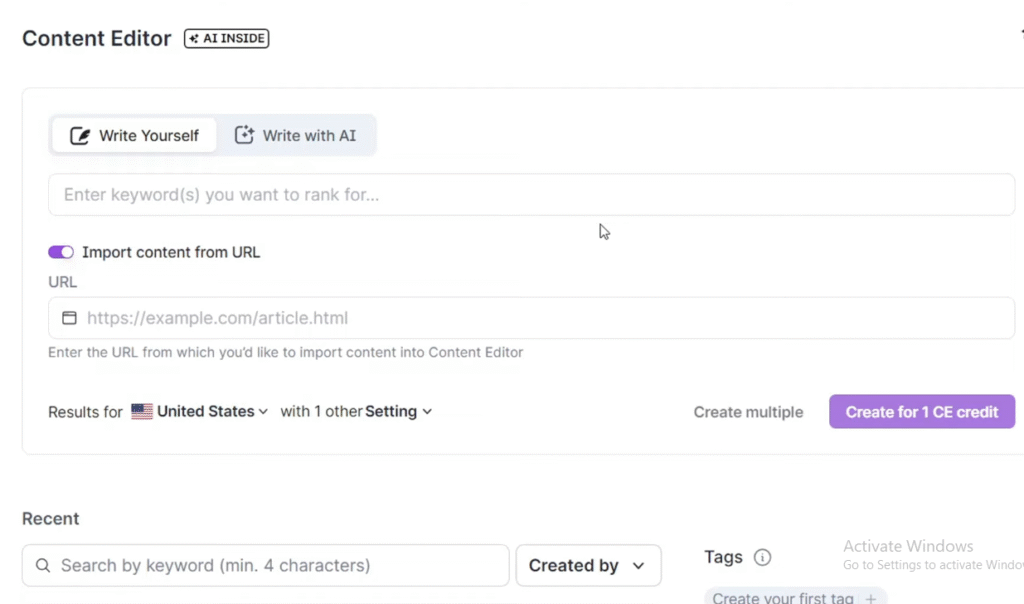Lorem ipsum dolor sit amet, consectetur adipiscing elit. Ut elit tellus, luctus nec ullamcorper mattis, pulvinar dapibus leo.
- Best AI Tools For Automation
6 Proven Ways I Optimize Content with Surfer SEO
Jump To
When you purchase through links on our site, we may earn an affiliate commission. Here’s how it works.
How do I optimize content using Surfer SEO?
I use Surfer SEO to write blog posts that rank by:
- Starting with the real search intent behind the topic
- Using the Content Editor to plan word count, headings, and structure
- Adding the most important keywords and related terms naturally
- Reviewing top-ranking competitors and finding content gaps
- Tracking my live Content Score to balance SEO and flow
- Using the Audit Tool to update old content and stay relevant
These steps help me create content that matches what people are searching for—so it ranks higher and performs better.

Ever poured your heart into writing a blog?
You spend hours writing a blog post, trying to get every word right. You included the keywords, added headings, and even looked at what your competitors are doing.
But your content disappears into Google’s graveyard?
I’ve been there. And the more I studied why it happens, the clearer it became: ranking content isn’t just about writing well. It’s about writing the right content in a way that matches what people are searching for.
That’s why I started using Surfer SEO.
It’s not a magic fix, but it gives me a clear path — from keyword selection to real-time content feedback. It helps me find out what’s missing in my content, how to structure it better, and what Google prefers to see.
In this article, I’ll walk you through the exact 6 things I do inside Surfer SEO to make sure my content has the best chance to rank, based on real work, not theory.
Let’s get into it.
Struggling with Traffic Despite Good Content?
Fix the gap with Surfer SEO’s optimization tools and see the difference on your next blog post.
1. I Start with Search Intent, Not Just Keywords
If your blog isn’t answering the right question, no tool can save it, not even Surfer.
That’s why I always begin by digging into search intent, not just chasing keywords with high volume. I ask myself:
“What exactly is the reader trying to solve when they type this?”
To get that answer, I look at what’s already ranking in Google. I scan titles, headings, and the types of content that dominate the first page — tutorials, listicles, thought leadership, or tools.
I use Ahrefs and SEMrush for my initial keyword research. I am not a fan of Surfer’s keyword tool. It’s fine for quick inspiration, but if you’re serious about intent, competition level, and SERP behavior, stick with the pros.
In keyword selection, I don’t care if a keyword has 10,000 searches, but if I can’t figure out the intent behind it, I’m not writing for it.
Here’s what I do instead:
- I open the Google SERPs for my main keyword
- I scan the top 5 results and ask myself:
“What kind of content is Google rewarding here?” - I check People Also Ask to get a quick idea of related questions
- I use Google’s autocomplete and scroll to the bottom for “related searches”.
From there, I build a quick mental map of what the audience wants — and what Google wants.
Only after that do I choose my keyword and open Surfer.
Once I’ve locked in my primary and secondary keywords, that’s when I head over to Surfer.
“Surfer is hands down one of the best tools for data-driven SEO.” — Jaime Ruiz de Castro (Trustpilot)
You Know What?
Most people rank for keywords but miss the intent behind them, and that’s why their bounce rate stays high and conversions stay low.
2. I Spy on Competitors — But Only the Smart Ones
Before I even start outlining, I study the competitors — but not all of them.
Some pages rank high just because the domain is strong. That doesn’t mean their content is good or even helpful. So, I focus only on the ones that actually deserve to rank.
PRO TIP
Don’t only rely on Surfer’s default competitor list. Use the manual selection to handpick strong pages that give you a real benchmark.
Here’s how I break it down:
Skip the weak ones: I ignore pages with outdated info, thin content, or too many ads.
Check their heading structure: I see how they break down the topic. What angles are they covering? What are they missing?
Look for real value: I check if they’ve actually answered the user’s query or just danced around it.
Find content gaps: If no one’s talking about a subtopic, I take the lead and add it in my own post.
This quick check shows me exactly what to do better — not just what to copy.
Not Sure If Your SEO Is Working?
Surfer SEO shows you what your content’s missing — in real time.
3. I Build My Draft in Surfer’s Content Editor

Once I’ve nailed the competitor research, search intent and picked the right keyword, I open up Surfer’s Content Editor. This is where the real work begins.
Surfer scans the top-ranking pages and gives me live recommendations — word count, headings, topics, terms, and structure. It’s like having a GPS for SEO content. But instead of blindly following it, I treat it like a framework, not a formula.
I never copy the structure it gives word for word. I use it to stay aligned with what’s expected in the SERP — and then I bring my own flow into it.
For example, if the top 10 pages are all 1,800 to 2,200 words, I try to land somewhere in that zone — but I’ll still trim anything that feels like fluff.
PRO TIP
Forget about monthly volume in the beginning. Open the top-ranking pages and ask yourself,
“What problem are they solving — and can I solve it better?”
4. I Improve Topical Coverage Using Surfer’s Term Suggestions
One thing that truly changed how I write content?
I stopped obsessing over one keyword — and started covering the entire topic.
Surfer SEO doesn’t just tell you what your target keyword is. It actually shows you the terms, phrases, and concepts Google expects to see when ranking top content for your topic. That’s what I use to build real topical authority — not just fluff up word count.
PRO TIP
Don’t just add terms to hit the green zone. Use them to build context. For example, if Surfer suggests “on-page SEO”, I add a paragraph breaking it down for beginners. That’s how I improve both topical relevance and user engagement at once.
I usually start by scanning all term suggestions, but when I want to focus on what Google considers most important, I toggle to NLP mode — this filters and highlights high-impact terms tied directly to Natural Language Processing.
But I don’t just blindly add those suggestions. Here’s how I do it right:
- First, I skim through all the suggested terms Surfer provides.
- I ignore generic or awkward ones and pick the ones that add depth.
- Then I edit existing paragraphs or add new ones not to stuff keywords but to explain things better.
- I use these terms to cover subtopics, answer user intent, and connect semantically relevant ideas — naturally.
This isn’t about keyword density. It’s about showing Google that I understand the subject better than anyone else on page one.
You Know What?
Surfer no longer uses Google’s NLP API — and honestly, it doesn’t need to. Its suggestions are data-backed from the top 20 results.
That means you’re writing content that reflects what’s already ranking, while still having the freedom to write in your voice.
5. I Polish Draft with Real-Time Content Score — But I Don’t Obsess Over It
Surfer’s real-time Content Score is helpful but it’s not the law.
I treat it like a compass, not a finish line. It shows if I’m heading in the right direction. But I don’t chase a perfect score just to please an algorithm. That’s how you end up with robotic content that nobody wants to read.
PRO TIP
A score between 72–85 works best for me. If I go beyond 90, it usually means I’ve over-optimized, and Google can smell it.
Here’s how I use it wisely:
- I watch the score as I write, but I don’t let it boss me around.
- If the score drops, I quickly check what I missed — maybe a suggested keyword, or maybe I’ve repeated something too often.
- I scan the suggestions, but I only follow the ones that feel natural.
- I read aloud to check the flow, making sure it still sounds like me — not a machine.
This way, my content stays optimized and human.
“Surfer’s Content Analyzer is incredibly easy to use. I just paste my content, and it gives me a score based on keyword use and term importance — all while helping me keep things human and readable.”
Source: G2 – Surfer SEO Reviews
You Know What?
Surfer doesn’t know your tone, audience, or brand. You do. Let the score guide you — but never let it hijack your voice.
6. I Use the Audit Tool to Rescue Old Posts
There’s something satisfying about giving your older blogs a second life, especially when they’ve started slipping in rankings. That’s where Surfer’s Audit Tool becomes my go-to.
I don’t treat my published posts as “done.” I treat them as living assets. Every few weeks, I review my traffic and rankings. If a blog post that once ranked well is now slipping or stagnating, it’s time for a rescue mission. I paste the URL into Surfer’s Audit Tool, and in seconds, it tells me what’s missing.
PRO TIP
When auditing, focus on content structure and term coverage first. Those two often make the biggest difference, even more than word count or keyword density
What do I look for?
- Missing terms Surfer suggests
- Terms under the NLP filter
- Under-optimized headings
- Content gaps compared to competitors
- Internal linking opportunities
- And sometimes… content that just rambles
Once I have that audit report, I don’t blindly follow every instruction. I use it as a priority map, showing me what’s hurting performance and what’s worth fixing.
Sometimes, just adding 4–5 key phrases and fixing your H2s is enough to jump a post from page 2 to the top 5. I’ve done it more than once.
You Know What?
Google doesn’t care when your blog was published — it cares when it was last improved. The fresher and more relevant your content feels, the more love it gets.
Wrapping Up: Real Content Optimization with Surfer SEO
After testing dozens of content strategies, I can confidently say this — Surfer SEO has helped me turn guesswork into a clear process. But the tool alone isn’t the magic. It’s how you use it.
I don’t chase high scores. I focus on real search intent, smart structure, and meaningful keywords. I use the Content Editor to guide, not control. I check competitors to find content gaps, not to copy them. I improve topical coverage using suggestions that make sense for the topic. And when something underperforms, I audit, fix, and revive.
If you’re serious about SEO content that actually ranks, this is the playbook I use — and now it’s yours.
You’ve Got the Strategy — Now Use the Tool
Turn your next blog into a ranking asset with Surfer SEO.
FAQs (Frequently Asked Questions)
1. How long does it take to see results after optimizing with Surfer SEO?
In most cases, you’ll start seeing ranking shifts within 2–4 weeks after optimizing content using Surfer SEO. However, this depends on your domain strength, content quality, and backlink profile.
2. Can I use Surfer SEO for free?
Surfer SEO offers limited free tools, like their SERP Analyzer demo, but to unlock full access to the Content Editor, Audit Tool, and advanced features, a paid subscription is required.
3. Is Surfer SEO good for beginners in content writing?
Yes, Surfer SEO is beginner-friendly. The interface is clean, and the Content Editor provides real-time suggestions, making it easy for new writers to follow SEO guidelines while staying focused on the topic.
4. Do I still need other SEO tools with Surfer SEO?
Yes. Surfer’s keyword research feature is basic compared to tools like Ahrefs, SEMrush, or SE Ranking. I personally prefer using Ahrefs for keyword discovery and then switching to Surfer for optimization and audits.
5. What is the difference between Surfer SEO and Surfer AI?
Surfer SEO is the core tool for on-page optimization. Surfer AI is an add-on that uses generative AI to create content drafts based on SEO guidelines. It’s useful for scaling but needs human editing to truly connect with readers.
6. Why is my content score not increasing even after following Surfer’s suggestions?
Sometimes, it’s not about adding more terms but improving structure, sentence clarity, or topical depth. Also, check if you’re missing any key phrases marked under Surfer’s “Terms” tab, especially NLP terms.
7. Does Surfer SEO still use NLP terms?
Yes. Although Surfer SEO no longer uses Google’s NLP API, it still highlights NLP-related terms through its own algorithms. You can even toggle NLP terms to view them separately while optimizing.
8. How often should I run a Surfer Audit on old content?
I recommend auditing your content every 3 to 4 months. Even top-ranking blogs can slip if they’re not updated according to Google’s evolving ranking signals.
9. Can I optimize image alt texts with Surfer SEO?
Surfer SEO doesn’t audit image alt text directly, but optimizing image metadata with relevant keywords manually is a great practice and complements your on-page strategy.
10. Is Surfer SEO enough to rank on the first page of Google?
Surfer gives you the technical edge, but SEO also depends on backlinks, user engagement, and content originality. Use Surfer as your on-page guide, but combine it with smart content strategy and off-page SEO.
11. What is the best content score range to aim for?
A good range is 72–85. Going beyond that can sometimes lead to over-optimization. It’s more important to sound human and helpful than robotic.
12. How do I know which competitors to analyze inside Surfer?
Avoid outdated, spammy, or authority-driven pages with thin content. Focus on pages that match your target audience’s intent and actually provide value.
13. What is topical coverage, and how does Surfer help with it?
Topical coverage means addressing the key ideas and subtopics related to your main keyword. Surfer helps by suggesting phrases and questions that Google expects in a high-quality post.
14. Can I use Surfer SEO for affiliate blogs or niche sites?
Absolutely. In fact, it’s perfect for affiliate marketers because it helps structure posts in a way that answers search intent and improves engagement, two things affiliate blogs often miss.
15. What does “Toggle to NLP mode” mean in Surfer?
It lets you filter suggested terms to show only those considered important by Surfer’s NLP model. These terms carry more weight in showing search engines you understand the topic deeply.
Subscribe To Our Newsletter
Ermus
- Best AI Tools For Automation
Our Recent
Blogs


Canva vs Lumen5: Which Video Maker Is Better for B2B Agencies?

YouTube SEO in 2025: How to Use vidIQ to Rank Higher and Grow Your Channel

GoHighLevel Funnel Automation for Client Retention: Post-Onboarding Guide


